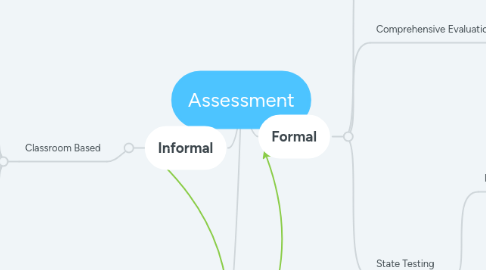Assessment
by Krystle Boga


1. Informal
1.1. Classroom Based
1.1.1. Curriculum Based
1.1.2. Criterion Based
1.1.3. Teacher Observation
1.1.4. Performance Assessment
1.1.5. Portfolio Assessment
1.1.6. Dynamic Assessment
1.1.7. Error Analysis
2. Cultural and Linguistic Factors
2.1. Overrepresentation/disproportionality
2.2. Standardized tests not required in other languages, although encouraged
2.3. Formal assessment evaluations offered in limited languages
2.4. IDEA 2004 Set standards and procedures to address cultural and linguistic issues
2.5. Low socioeconomic status
2.6. Being males
2.7. Having siblings in ESE
2.8. Bias in tests and screenings, therefore multiple forms of evaluation are needed
3. Formal
3.1. Standardized Tests
3.1.1. SAT
3.1.2. ACT
3.1.3. Alternative Assessment
3.2. Comprehensive Evaluation
3.2.1. RTI Process/Data Collection
3.2.2. Ecological Assessment
3.2.3. Norm-Referenced Tests
3.2.4. Classroom Observations and Interviews
3.2.5. Standardized Tests
3.3. State Testing
3.3.1. Pros
3.3.1.1. Holds teachers accountable
3.3.1.2. Holds students accountable
3.3.1.3. Provides Data
3.3.1.4. Requires teachers to include ESE students with Gen. Ed to meet academic needs
3.3.2. Cons
3.3.2.1. High Stakes
3.3.2.2. Reliability
3.3.2.3. Effectiveness
3.3.2.4. Cost
3.3.2.5. Can be too difficult or unrealistic for some ESE populations

